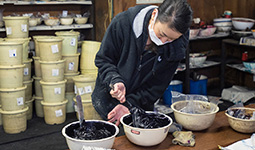Home > Highlighting JAPAN > Highlighting Japan January 2017 > Traditional Crafts
Highlighting JAPAN


Capital Fabrics
Tomita Some Kogei is the last remaining exponent of a most refined traditional craft.
Along the Kanda Josui canal, near the center of one of Tokyo’s hippest, most cosmopolitan districts, lies a workshop that seems to belong to a bygone era.
Indeed the atelier, Tomita Some Kogei, opened its doors over a century ago to produce one of Japan’s most traditional and culturally significant crafts.
Tokyo Some (pronounced “so-may”) Komon is a type of resist-dyeing whose designs are so intricate that from a distance they are all but indiscernible.
Inside the labyrinthine wooden building in the Takadanobaba neighborhood of Shinjuku Ward, artisans mix viscous multicolored concoctions and steam and wash endless lengths of material.
In a vast concrete-floored room, sheets of white cloth are pinned to work surfaces that stretch almost the full length of the room. Onto these, craftsman Takushin Asano places a stencil and deftly “paints” on the thick nori dye using a playing card-size hera (spatula). Most of the fabric produced is used to make kimono.
“If you apply too little or too much pressure the print comes out blotchy and uneven,” he explains as he moves at a surprising tempo along the work surface, repeating the dye printing process several times per sheet of cloth. “Finding the right pressure to apply comes with experience.”
Experience is something the 73-year-old Asano has in spades. He is now in his fifty-third year at Tomita Some Kogei, but started working in the industry aged 10, when he would wash dyed cloth for neckties in the Tama-gawa river near his parents’ atelier in Setagaya Ward — a practice outlawed in the 1960s under new anti-pollution regulations.
“When I started there were about 300 workshops, but now only ours remains,” says Asano.
Much of the production process remains unchanged. The nori dyes are manufactured from a mixture of powdered glutinous rice and rice bran, which is steamed and kneaded before coloring agents are added, while, the stencils (katagami), are made from two or three sheets of washi paper that are stuck together using persimmon tannin.
The intricate designs are mostly created by specialist artisans using age-old stenciling techniques, such as kiri-bori and tsuki-bori, that are employed with an array of hand-made cutting implements that resemble awls and chisels.
A standard 36-cm-square stencil takes artisans about one month to make and costs between 300,000 and 900,000 yen (2,500 and 7,500 dollars), explains Atsushi Tomita, president of Tomita Some Kogei. “The price is linked to the intricacy of the design,” he says, adding that his company stocks around 120,000 stencils, some dating back to the company’s inception.
Once the stenciling is complete, the material is dried and a secondary, base dye known as ji-iro is applied with a larger spatula. The cloth is then steamed to fix the color and washed to remove any excess nori.
According to Tomita, demand for the fine-pattern material peaked during the seventeenth century, when the nation’s daimyo lords competed for designs to make them stand out during gatherings in the capital, Edo, that were mandated by the Tokugawa shogunate every two years. As a result, Edo, which is the old name for present-day Tokyo, became a thriving production center for the daimyo’s kamishimo ceremonial attire.
While the patterns were all unique to reflect each vassal’s regional seat, a characteristic feature of each was that the pattern was only distinguishable from a distance of a few meters.
During the Edo period (1603–1867), the fabric using the dyeing technique found a wider clientele, when it was used to make a more modest kimono for the merchant class to distinguish them from samurai.
At Tomita’s atelier, Tokyo Some Komon — which was recognized as a national traditional craft in 1974 — is also used to make bags and a variety of other accessories, including ties and shawls made from gossamer silk and dyed in a Calico-like style known as “Edo sarasa.”
Fabric for kimono, however, remains the company’s mainstay.
“Fewer people are wearing kimono today, so demand is lower, though we still produce around 30 bolts of fabric per week,” Asano says.
“Such fashions are cyclical and there are still people who love kimono and who, like us, want to ensure that this traditional craft continues to survive.”
© 2009 Cabinet Office, Government of Japan









